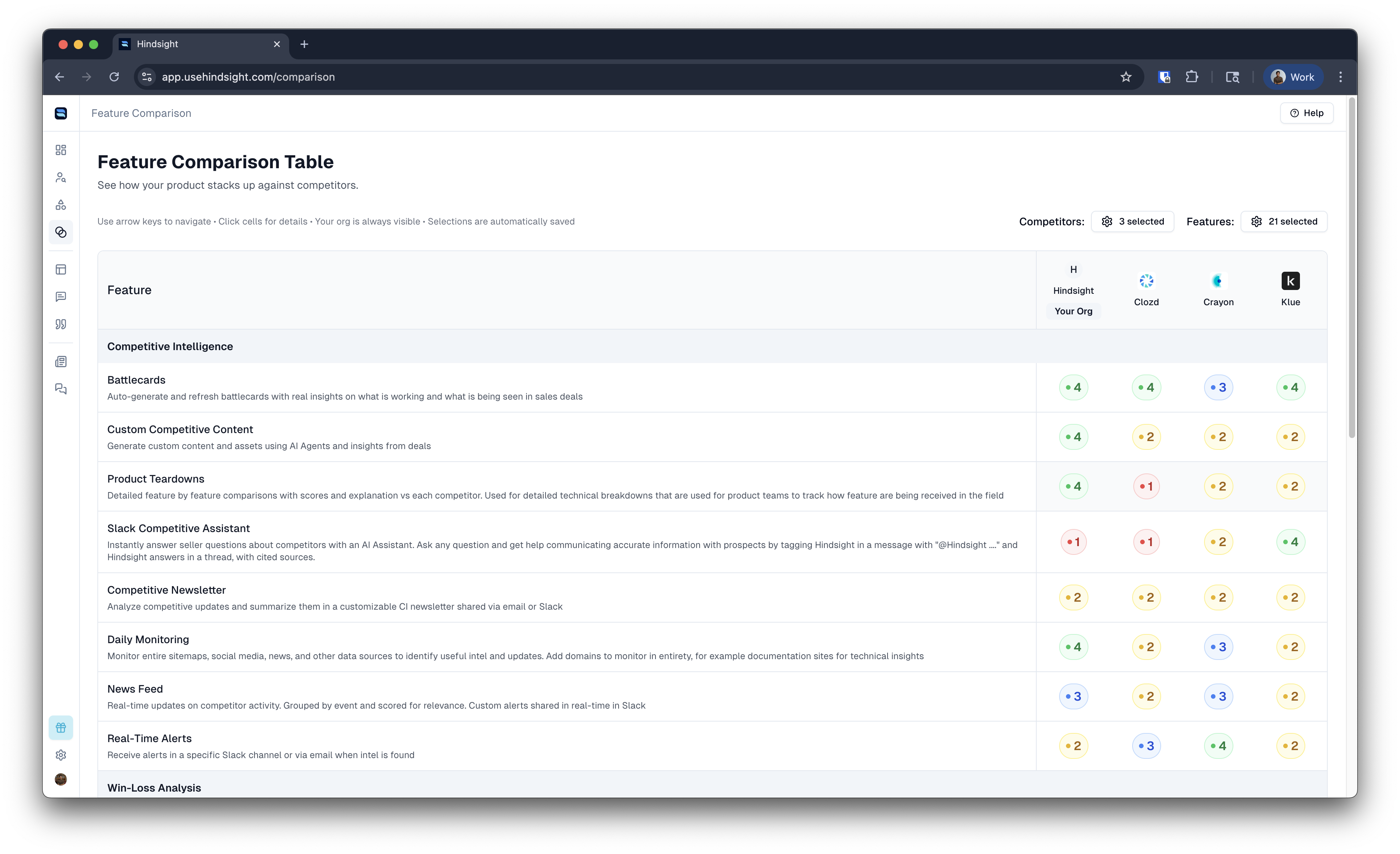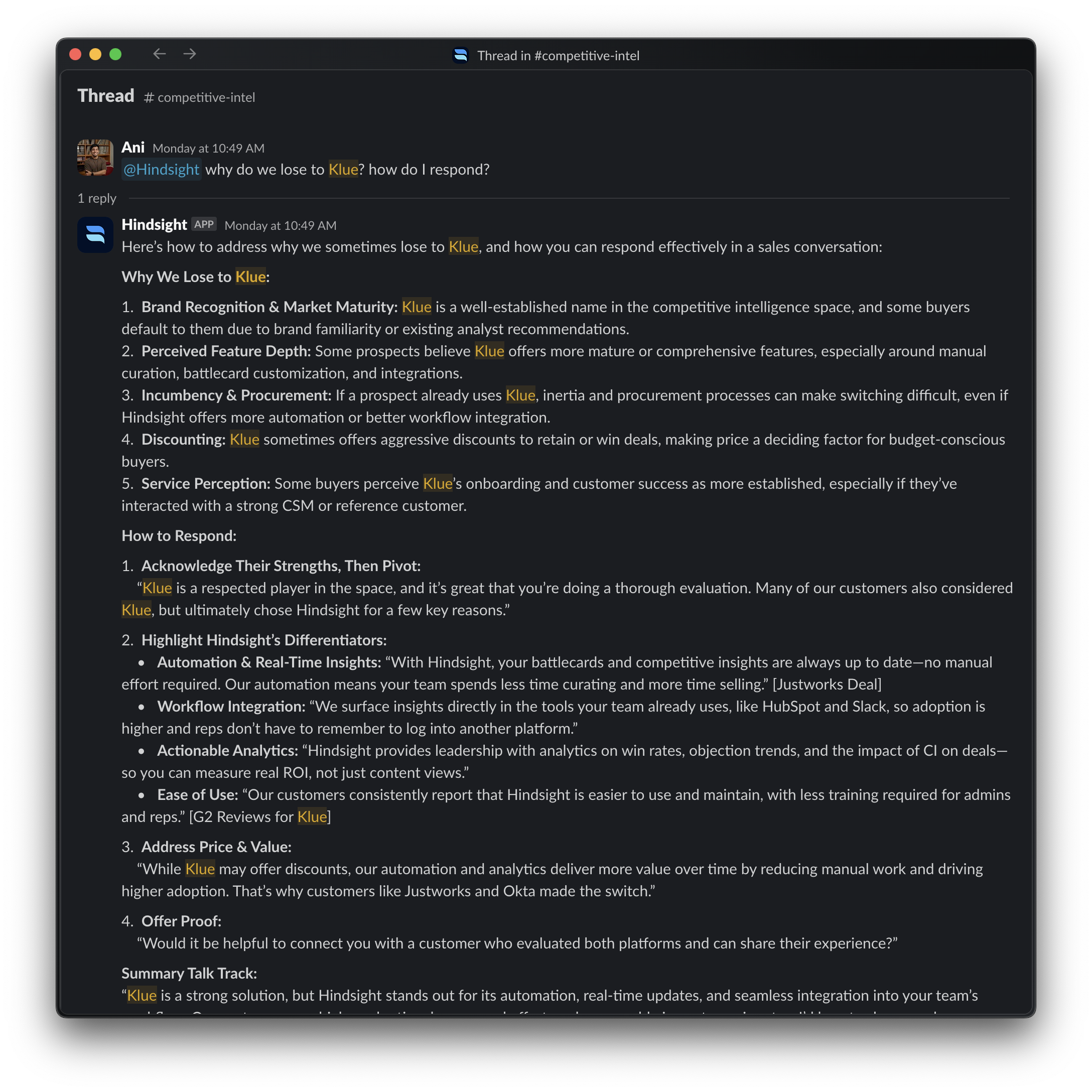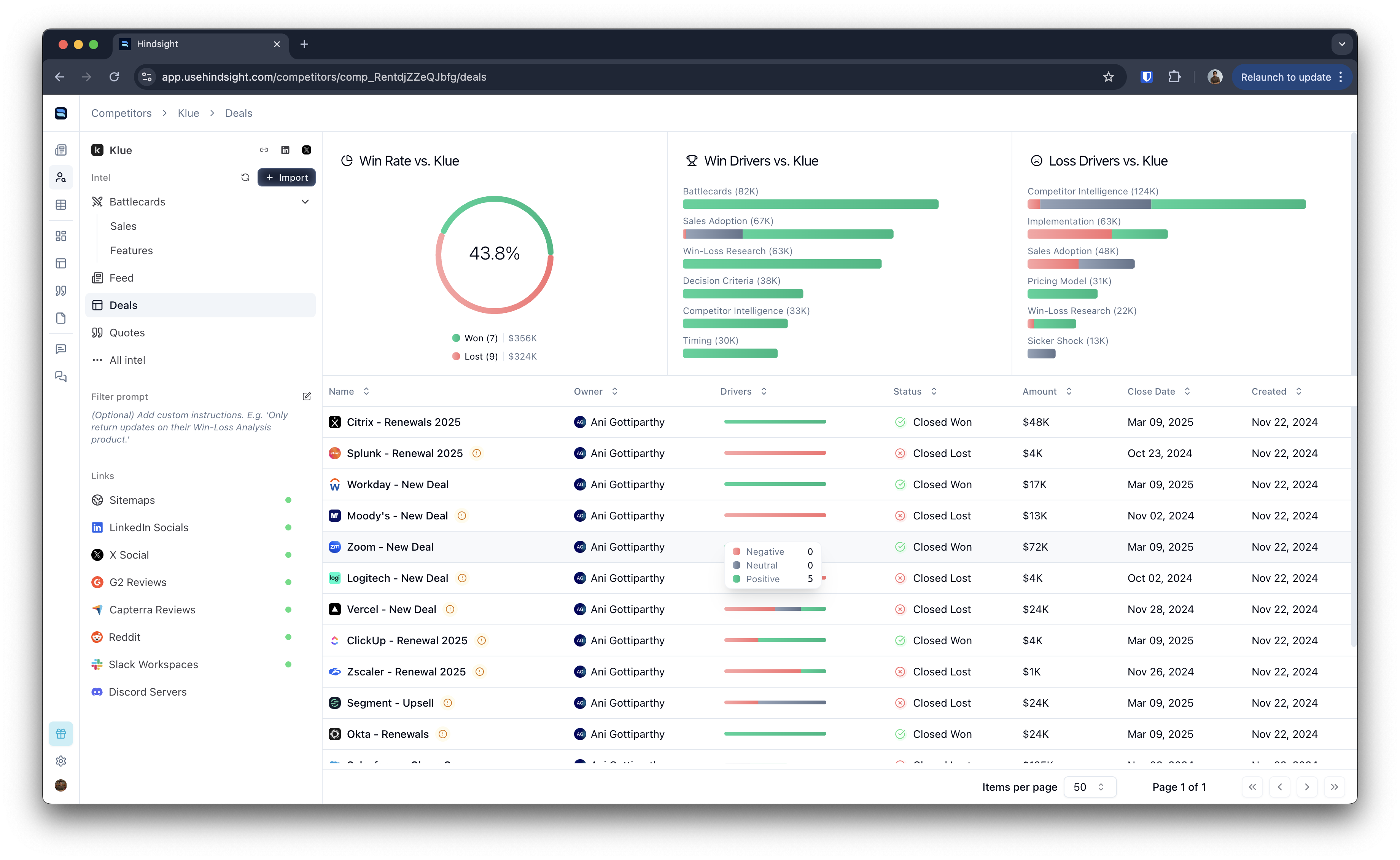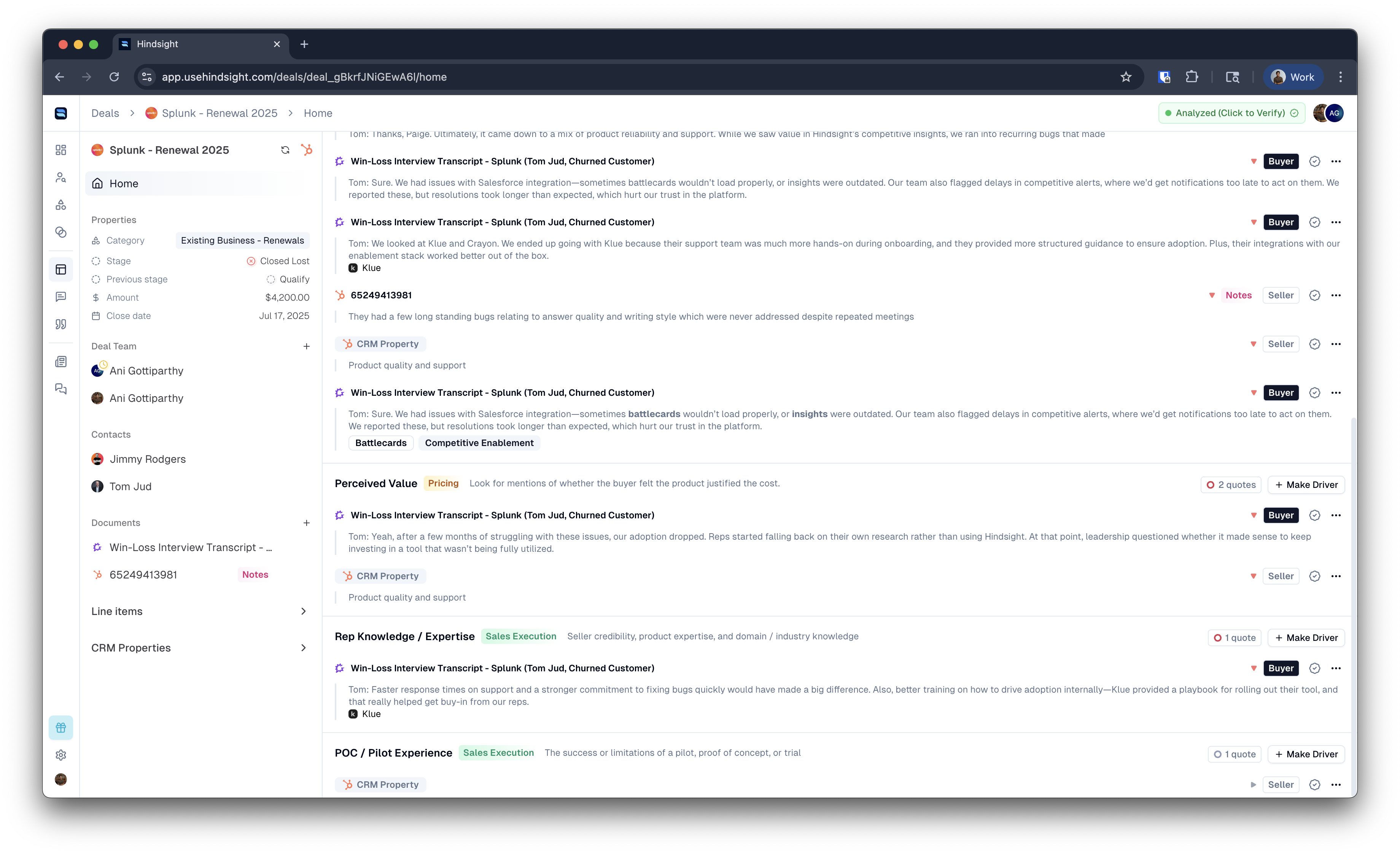Product Manager’s Guide to Hindsight
Hindsight transforms how Product Managers gather competitive intelligence, understand customer needs, and make data-driven product decisions. This guide covers the key features most relevant to Product Management teams.The Product Manager’s Challenge
Most product teams struggle with the same fundamental issues: Before Hindsight:- Anecdotes and loud voices drive product priorities - the squeakiest wheel gets the grease
- Manual digging for field insights - spending hours in Gong recordings and Salesforce notes, or constantly asking sales for their opinion
- No way to quantify trends - unable to measure which features actually drive revenue impact
- Understand what features are driving impact - see which capabilities win and lose deals
- Identify opportunities to close feature gaps - know exactly where competitors beat you
- Access a detailed quote bank - hear what buyers are actually saying about features
Key Features for Product Managers
1. Harvey Ball Feature Comparison Views
Get instant visual clarity on your competitive positioning with our feature comparison matrix.
- Side-by-side comparisons of your product vs. competitors across key features
- Harvey Ball scoring (1-4 scale) for quick visual assessment
- Evidence-backed insights with links to source documents and specific deals
- Automatic updates as competitor intelligence comes in
- Set up your Features catalog
- Add descriptions for capabilities you want to track
- AI automatically analyzes competitor feature support by researching the web and looking across deals
- View comprehensive matrix at Comparison > Feature Matrix
- Product roadmap planning sessions
- Competitive positioning discussions
- Feature prioritization decisions
- Executive briefings on competitive landscape
2. Natural Language Competitive Intelligence Chat
Ask questions about competitors and deals using natural language and get instant, evidence-based answers.
- “What are Salesforce’s strengths and weaknesses in enterprise deals?”
- “How does HubSpot’s pricing compare to ours?”
- “What features do customers request most when comparing us to [competitor]?”
- “What’s the latest news about Microsoft’s product updates?”
- “How do customers perceive our AI capabilities vs. competitors?”
- Slack integration:
@Hindsight [your question] - Web interface: Chat directly in the Hindsight platform
- Deal-specific context: Ask questions within specific deal conversations
- Uploaded competitive documents and battlecards
- Sales call transcripts mentioning competitors
- Deal intelligence from your CRM
- External research from websites, reviews, and documentation
- Customer win/loss interviews
3. Win/Loss Analytics Against Top Competitors
Understand exactly how you perform against specific competitors and identify patterns.
- Win rates against each specific competitor
- Deal frequency - how often each competitor appears in your deals
- Deal size impact - how competitor presence affects deal values
- Feature gaps - capabilities where competitors consistently win
- Trends over time - improving or declining performance
- Market share of competitive deals
- Average deal cycle when specific competitors are involved
- Most common objections by competitor
- Success patterns by product area or market segment
4. Automated Competitor Monitoring
Stay ahead with AI-powered competitive intelligence that never sleeps.
- Product releases and feature announcements
- Pricing changes and new packaging options
- Partnership announcements and integrations
- Leadership changes and strategic shifts
- Customer wins and case studies
- Job postings indicating product direction
- Weekly newsletter with summarized competitive updates
- Real-time Slack alerts for high-priority changes
- Custom notifications based on your specific interests
- News feed filtering by competitor, relevance, or content type
5. Feature Impact Analytics & Quote Intelligence
Extract product insights directly from customer conversations with automatic feature detection and impact scoring.
- Quotes are tagged with features - AI identifies when specific capabilities are discussed
- Sentiment analysis and impact scoring - understand positive/negative mentions and deal influence
- Automatic summaries - get the key themes without reading every conversation
- Score vs. competitors - how you stack up on each capability
- Deals and summaries - specific deals where the feature impacted the outcome
- Quote bank - actual buyer and seller conversations about the feature
- Feature requests mentioned in sales calls
- Pain points with current solutions
- Competitive comparisons customers are making
- Use case priorities by customer segment
- Integration requirements and technical needs
- Sales call transcripts and recordings
- Email conversations with prospects
- Win-loss interview responses
- Customer support interactions
- Proposal feedback and negotiations
6. Decision Driver Analysis
Understand what really drives purchase decisions in your market.
- Automatic tagging of decision factors in deal conversations
- Trend analysis of which drivers matter most by segment
- Competitive positioning on key decision criteria
- Feature prioritization based on actual customer decisions
- Market insight into evolving buyer priorities
How to Use Hindsight’s Features Section
The/features section is your command center for data-driven product decisions. Here’s how to maximize its value:
Setting Up Your Feature Catalog
Step 1: Define Your Features- Add specific capabilities like “SSO Integration,” “API Rate Limiting,” or “Custom Dashboards”
- Categorize by Product Line and Product Area (e.g., Security, Integrations, Analytics)
- Include detailed descriptions to help AI understand the feature scope
- Analyzes competitor feature support by researching the web and deal conversations
- Scores each feature on a 1-4 scale with detailed explanations
- Tracks mentions across all your sales conversations
- Updates intelligence as new data comes in
Reading Feature Intelligence
For each feature in your catalog, you’ll see: Competitive Scoring:- How you compare to each competitor (1-4 scale)
- Evidence and sources supporting each score
- Trends over time in competitive positioning
- Specific deals where this feature influenced the outcome
- Win/loss correlation with feature strength
- Deal size impact when feature is a differentiator
- Direct quotes from buyers about the feature
- Sentiment analysis (positive/negative/neutral)
- Common themes and patterns in feedback
- Feature requests and enhancement suggestions
- How often the feature comes up in competitive situations
- Which competitors are strongest/weakest in this area
- Emerging trends in customer requirements
Getting Started: Quick Setup for Product Teams
1
Set Up Your Feature Catalog
Navigate to Product Insights and define the capabilities you want to track competitively. Include detailed descriptions to help AI understand feature scope.
2
Add Key Competitors
Add your main competitors at Competitors. Include specific instructions for AI monitoring (e.g., “focus on API and integration features”).
3
Configure Decision Drivers
Set up the key factors that drive customer decisions in your market at Decision Drivers.
4
Connect Your Data Sources
Integrate with your CRM and meeting tools to start analyzing customer conversations for product insights.
5
Set Up Slack Integration
Install the Hindsight Slack app to get real-time competitive intelligence and enable natural language queries.
Pro Tips for Product Managers
- Start with High-Impact Features: Focus your initial feature catalog on capabilities that frequently come up in competitive deals.
- Monitor Feature Trends: Use the features section to track which capabilities are becoming more/less important to buyers over time.
- Leverage Quote Intelligence: Use direct customer quotes to build compelling business cases for feature investments.
- Track Competitive Gaps: Identify features where competitors consistently beat you and prioritize closing those gaps.
- Cross-Reference with Win/Loss: Look for patterns between feature strength and deal outcomes to guide roadmap prioritization.
- Share with Sales: Use feature intelligence to update battlecards and train sales on positioning.
Common Product Manager Use Cases
Feature Prioritization:- “Which features are mentioned most often in deals we lose?”
- “What’s the revenue impact of our API limitations vs. competitors?”
- “How do enterprise customers talk about security requirements?”
- “Show me all customer quotes about [competitor]‘s integration capabilities”
- “Where are we strongest/weakest vs. [competitor] according to actual deals?”
- “What features do customers request when comparing us to the market?”
- “What new capabilities are customers asking for across all deals?”
- “How has the importance of [feature] changed over the last 6 months?”
- “What technical concerns do prospects raise most often?”
- “Which feature investments would have the biggest impact on win rates?”
- “What do customers say about our [feature] compared to competitors?”
- “Where should we focus engineering resources based on deal intelligence?”
Measuring Success
Track how Hindsight improves your product management effectiveness:- Faster competitive response to market changes
- More informed roadmap decisions based on customer feedback
- Better win rates through competitive feature positioning
- Improved cross-team alignment on product messaging
- Data-driven feature prioritization replacing gut instinct
Ready to transform your competitive intelligence? Start with our quickstart guide or dive directly into competitive monitoring. For product-specific questions, reach out to your Customer Success team or use the in-app chat to ask our AI assistant directly.
